This site is part of various affiliate programs. Links may give us a small compensation for any purchases you make, at no additional cost to you. Please read the disclaimer policy for full details.
The absolute best Canon lens for family portraits is the Canon EF 85mm f/1.8, but there are plenty of alternatives which we will cover below.
If you are considering getting into family portraits, be it for your own family or as a possible business opportunity, you’ll need to invest in at least one more suitable lens.
If you are a Canon shooter, we can help you out with your choice thanks to our extensive experience creating portrait pictures with the Canon ecosystem.
Family portraits often look pretty simple to make, but once you start shooting some family portraits, you realize that there is way more skill needed than you would expect!
There is a particular look you need to achieve for the portraits to look professional and pleasing, and unfortunately the kit lenses that come with Canon cameras simply can’t get you there.
Depending on the family portraits you are going for, the ideal lens choice obviously changes, but you might be suprised to learn that you can do pretty much everything with one or two lenses, depending on your shooting style.
In this article, we will review the following lenses:
- Canon EF 85mm f/1.8 USM
- Canon EF 50mm f/1.8 STM
- Sigma 35mm f/1.4 DG HSM Art
- Canon EF 24-70mm f/2.8L USM
- Sigma 50-100mm f/1.8 DC HSM Art
- Canon RF 85mm f/2 IS STM Macro
- Canon RF 50mm f/1.8 STM
- Canon RF 35mm f/1.8 IS STM Macro
- Canon RF 24-70mm f/2.8L IS USM
- Canon RF 70-200mm f/2.8L IS USM

The Best Canon Lens for Family Portraits – Canon EF 85mm f/1.8
Our top pick for DSLR shooters
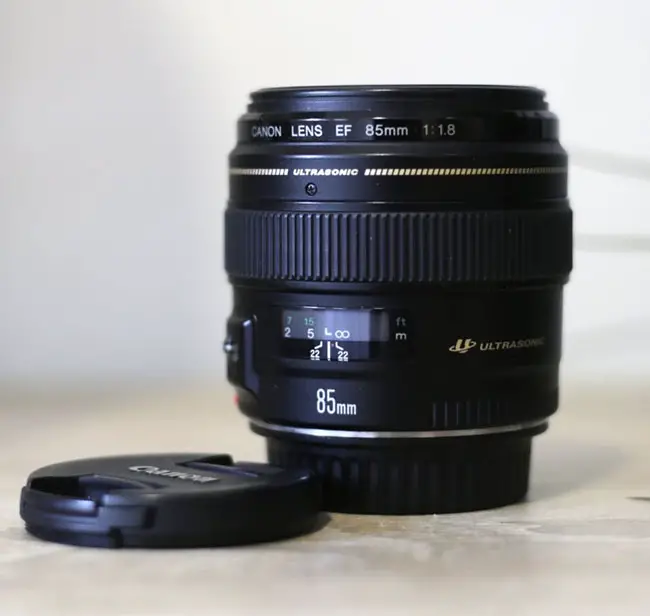
- Excellent image quality for the money
- Rich and true-to-life color and contrast rendition
- Quick and accurate autofocus motor
- Perfect for individual portraits or group shots from a distance
- Excellent price for the performance
The Best Canon Lens for Family Photography for RF Mount – Canon RF 85mm f/2
Our top pick for the mirrorless shooters
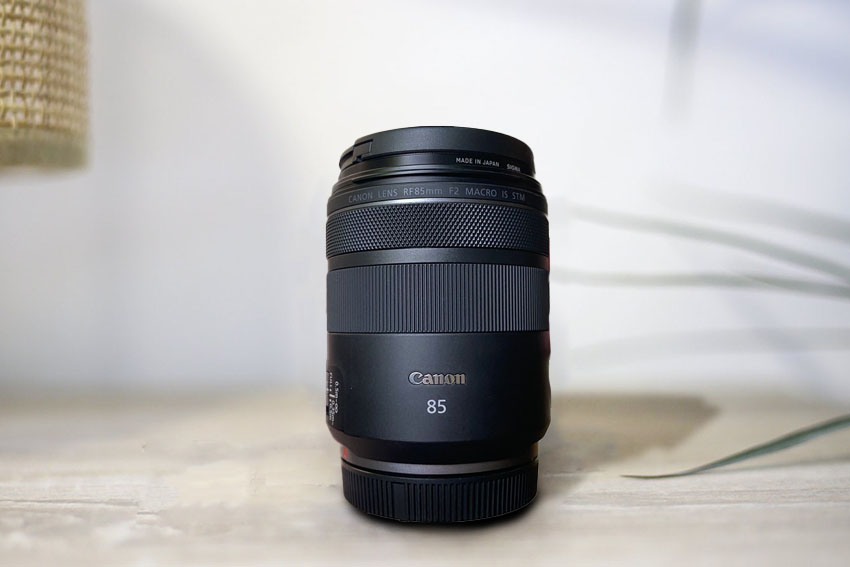
- Great image quality for the money
- Well-controlled chromatic aberration
- Can shoot macro
- Has very good Image Stabilization
- Great price
Comparison of the Best Canon Family Portrait Lenses
Lens | Mount | Image Stabilization | Who's it for? | Check Price | |
EF | No | If your main intention is to photograph a single person, or a small group, then this lens is the perfect budget option | |||
EF | No | This is a great backup lens since it is dirt cheap and a good performer | |||
EF | No | If you shoot larger groups of people with the occasional close-up portrait | |||
EF | No | If you want one lens for all family photos | |||
EF | No | If you use APS-C cameras and you want the full frame 70-200mm f/2.8 look | |||
RF | Yes | If you need a well-designed, sharp, stabilized, and macro-capable portrait lens that doesn’t cost a small fortune | |||
RF | No | If you shoot portraits and groups while craving some background compression and bokeh | |||
RF | Yes | If you shoot larger groups of people more often | |||
RF | Yes | If you want one lens to rule all the family portrait needs | |||
RF | Yes | If you shoot primarly single person portraits, and portraits of moving subjects |
How to Choose the Best Lens for Family Portraits
The most important thing to consider before buying a lens for family portraits is precisely what you are going to shoot – family portraits can mean different things to different people.
We’re going to cover all the key factors that matter on a lens and how these change the types of family photos that you can take with them, so that you can be sure you are making the right decision before spending your money on a lens.
Focal Length
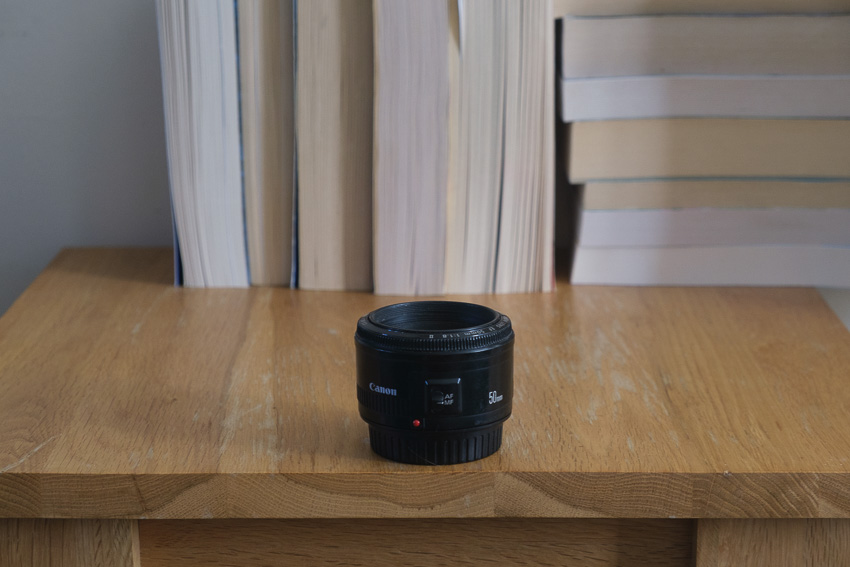
Depending on what kind of family portraits you shoot the most, the focal length will be the first determining factor.
If you are shooting groups of people more often, then a wider lens is preferable, something in the range between 24mm and 85mm.
On the other hand, if you are shooting one person at a time, or at most 2-3 people at a time, then a longer focal length will provide more flattering images, within 50mm to 200mm. Still, usually, you’ll end up sticking around 85 to 100mm due to the distance to the subject.
There are lenses with variable focal lengths, or zoom lenses for short, where you get a range of focal lengths at the expense of maximum aperture and price. Usually, wide apertured zoom lenses, like the 24-70mm f/2.8, hold higher prices than a 50mm f/1.8, for example.
Maximum Aperture
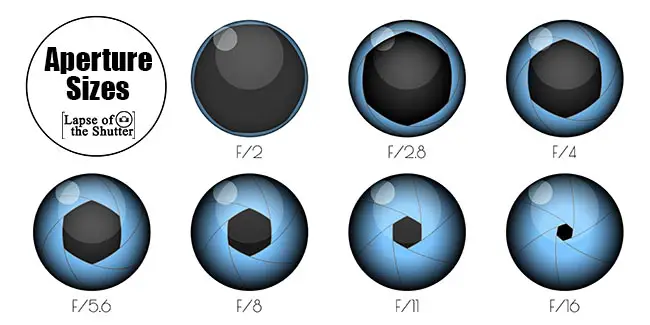
The maximum aperture determines how much light enters the lens and how much background blur there will be. The more light the lens gathers, the lower your ISO will be; thus, your portraits will be cleaner.
The more background blur you can muster, the more accentuated the portraits will be. So a wider maximum aperture is always welcome for family photography.
Background Compression
When using lenses with longer focal lengths, the background appears closer than it actually is. When using wide-angle lenses, the background appears further away than it actually is. That is called background compression, and it is a useful tool for your compositions.
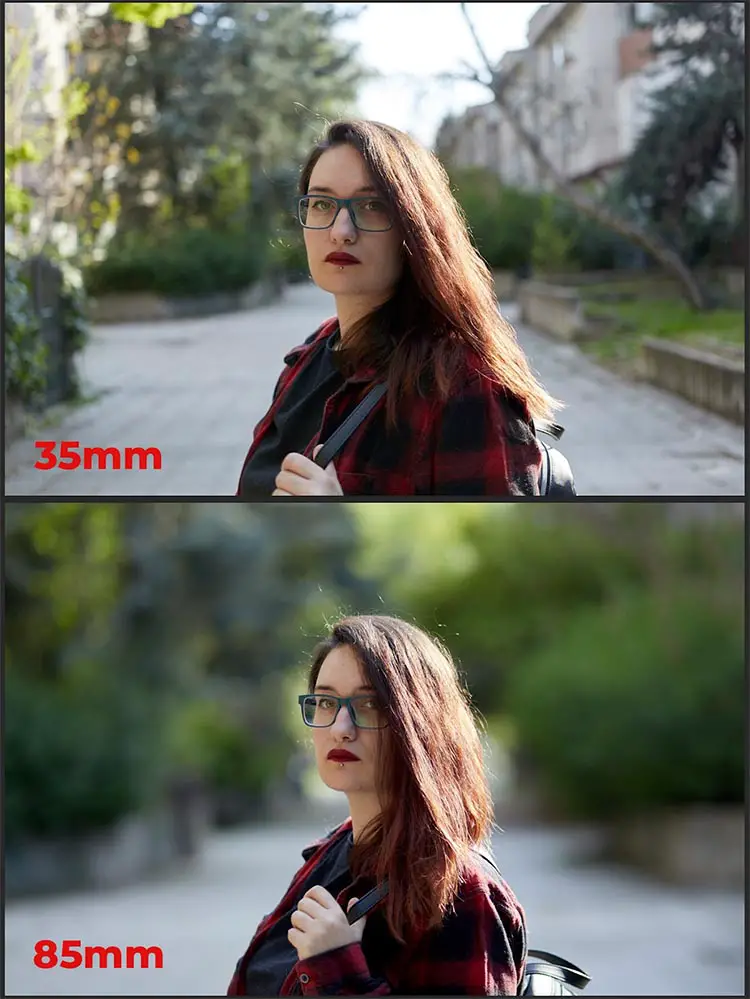
Usually, lenses that compress the background more (telephoto lenses) allow you to shoot in a larger variety of locations since you can hide the surroundings more by compressing the background.
The compressed background leads to even more background blur for the same aperture, which is why telephoto lenses have more bokeh for the same aperture than wide-angle lenses.
Lens Mount
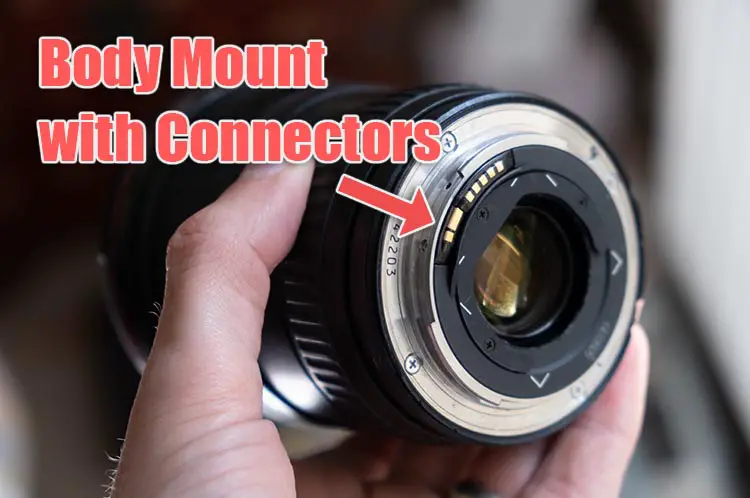
This should be obvious, but many people make the mistake of purchasing a lens for a different mount, thinking it will fit on all Canon cameras if it is a Canon lens.
You can only use EF mount lenses if you have a full-frame Canon DSLR. You can use both EF and EF-S lenses if you have an APS-C Canon DSLR.
If you have a Canon mirrorless camera, then you can use RF lenses natively or EF lenses with a lens mount adapter. However, getting native RF glass for your RF camera is recommended.
Sharpness and Lens Defects
Most modern lenses are plenty sharp for all intents and purposes. However, some lenses are sharper than others, and more sharpness is always welcome.
All lenses suffer from defects like Vignetting, Chromatic Aberrations, Ghosting and Flaring, and Distortion. The fewer defects the lens has, the better.
However, realistically there always will be some lens defects present. The fewer there are, the higher the price of the lens.
Image Stabilization
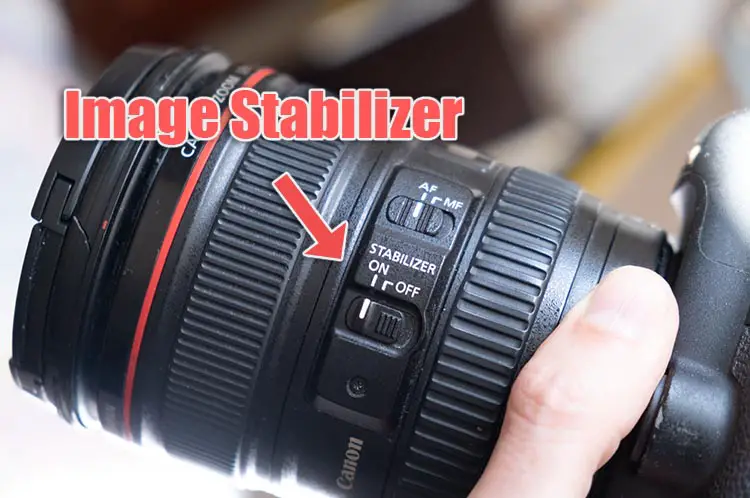
Most of the time, you will be shooting handheld, and with handheld shooting comes camera shake. Lenses with image stabilization remove a good chunk of that camera shake, and thus you end up with sharper images due to less (or no) motion blur.
Even though the Image Stabilization often adds a bit of weight to the lens, it is not that significant, and it is a feature definitely worth having.
Autofocus Motor
Most of the lenses you’ll find for portraiture are autofocus lenses. However, not all of them use the same autofocus motor. The type of autofocus motor determines how loud the autofocusing is, how fast it is, and how accurate it can be. Canon uses mostly STM and USM motors in their lens lineup.
The STM stands for stepper motor, and the USM for an ultrasonic motor. Of the two, the Ultrasonic motor is faster and quieter, and often more accurate.
The STM motor, on the other hand, is smoother and produces a little bit of sound, but only you will be able to hear it since the camera is literally in front of your face. Your models won’t hear a thing.
Build Quality
It is obvious that lenses that are better built are going to last longer. So, sometimes it is better to invest a bit more in a better-built lens so you don’t regret your purchase when it fails on you when you need it the most.
Reviews of the Best Canon Lenses for Family Portraits
Below, you’ll find our picks for the best lenses for Canon for family portraits. Bear in mind that we update this list regularly as new lenses come out. So feel free to bookmark this article, as it might also be helpful for you later on.
We’ll start by looking at EF mount lenses and then move onto RF mount lenses.
Canon EF Mount Lenses
1. Canon EF 85mm f/1.8 USM [Best Family Portrait Lens]
Specifications:
- Mount: EF Mount
- Closest Focusing Distance: 85cm
- Magnification: 0.13x
- Autofocus Type: USM
- Image Stabilization: No
- Filter Thread: 58mm
This lens is among the oldest Canon 85mm lenses that are still in use. It was released in 1992 and is still relevant, a testament to Canon’s lens quality.
Image Quality
As it is around 30 years old and designed primarily for film cameras, the lens is starting to show its age. That doesn’t mean that the lens isn’t sharp, and it actually is plenty sharp for the price, even wide open. You will notice some sharpness fall-off towards the corners, but depending on your shooting style, you might actually like it. You won’t see the sharpness fall off if you use an APS-C camera.

If you stop down the lens to f/2.8, you’ll see the corner sharpness improve, and overall sharpness will get even better. You’ll see that the vignetting improves quite a lot at this aperture, dropping to -0.7EV from -1.5EV when wide open. At f/5.6, the vignette is almost entirely gone.
Chromatic aberration is present and noticeable when shooting wide open, but if you stop down just a little to f/2.2, for example, most of it will be gone. At f/2.8, CA is not a problem anymore. Most of the CA, when wide open, can be corrected via profile corrections in Lightroom, and you can remove pretty much all chromatic aberration from f/2.2 onwards.
There is no significant distortion, and flaring is well controlled. You will notice some glare with high-intensity light sources in the frame, but it is not a huge problem. Many people actually use special filters to produce that glaring intentionally, so there is that.
All in all, this 30-year-old lens performs very well.
Build Quality
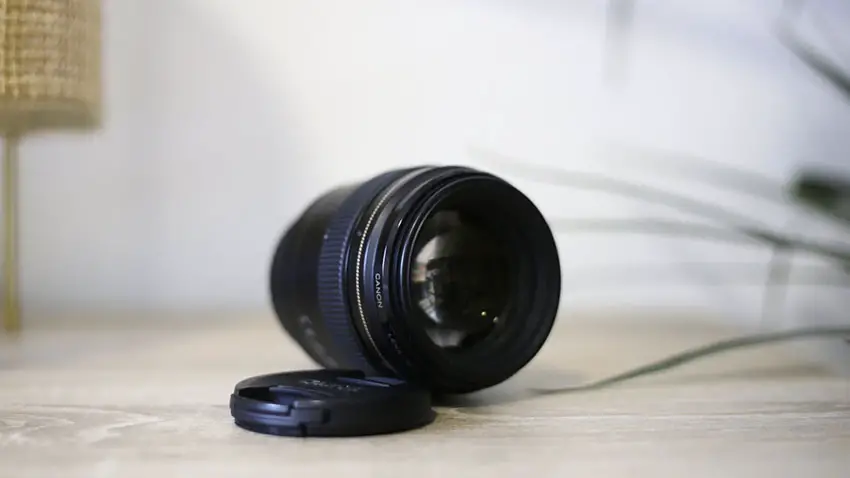
It is a plastic-built lens on a metal mount. The plastic isn’t of the cheap kind, so the lens can take some beating.
Bear in mind that it is considered a budget lens, so you won’t find weather sealing here. Dust is like kryptonite for this lens. It tends to get in between the lens elements, and you can’t clean it yourself. So when the dust gets in there, and it eventually will, it is a trip to the service center for cleaning. It shouldn’t cost a fortune, but it is a recurring cost.
You will find fast and accurate autofocus thanks to the USM motor. It is among the fastest-focusing 85mm prime lenses on the market.
Weighing in at 425 grams, it is not a heavy lens, so it won’t be burdensome to use.
Who is the Canon EF 85mm f/1.8 USM for?
If you shoot a Canon DSLR, and your main intention is to photograph a single person, or a small group, then this lens is the perfect budget option. It has a wide f/1.8 aperture, it is sharp, and provides nice and flattering portraits, making it the best family portrait lens.
- Pros:
- Excellent image quality for the money.
- Great and accurate color rendition.
- Decent control over ghosting and flaring.
- Decent build quality for the money.
- Excellent price to performance.
- Among the fastest autofocusing prime lenses, with great accuracy.
- Cons:
- No weather sealing.
- Dust will eventually get in between the lens elements.
- No image stabilization.
Read More:
2. Canon EF 50mm f/1.8 STM
Specifications:
- Mount: EF Mount
- Closest Focusing Distance: 35cm / 1.15ft
- Maximum Magnification: 0.21x
- Autofocus Type: STM
- Image Stabilization: No
- Filter Thread: 49mm
Image Quality
The 50mm f/1.8, also known as the “nifty fifty,” is the entry-level portrait lens offered by nearly every manufacturer on the market.
Canon’s own 50mm f/1.8 STM is plenty sharp, wide open, with some sharpness fall-off in the corners. The fall-off is only visible if you use it on a full-frame camera. If you stop down the lens to f/5.6, it becomes sharper both in the center and in the corners, reducing the sharpness difference between the two.

There is plenty of vignetting in the extreme corners at around -2.5EV, and it doesn’t get better until f/2.8, but many photographers actually like this. You’ll notice most of the vignette going away between f/2.8 and f4, where it reduces to -1EV. The vignette is not a problem for photographers with APS-C cameras.
You’ll notice that the chromatic aberration is well controlled, especially considering that this is a $130 lens. You can remove most, if not all, chromatic aberration in Lightroom.
The lens presents some flaring and some glare, but it doesn’t look ugly and cheap. If you are one of those photographers that actually like a little flare to add some character, this will be a bonus for you.
Another thing you’ll notice is that even though this is an extremely cheap lens, Canon made sure that the color and contrast look great. There is a bit of micro-contrast deficiency, but it might be a good thing for family portraits. It makes flattering photos of the elderly.
It renders background blur quite well for a cheap lens.
Build Quality
Unlike the previous generation of this lens, dubbed “Plastic Fantastic,” this lens leans more towards fantastic. It is still plastic on a metal mount, but the quality of the plastic has improved significantly. It has a bit of premium feel, even though it is a cheap lens.
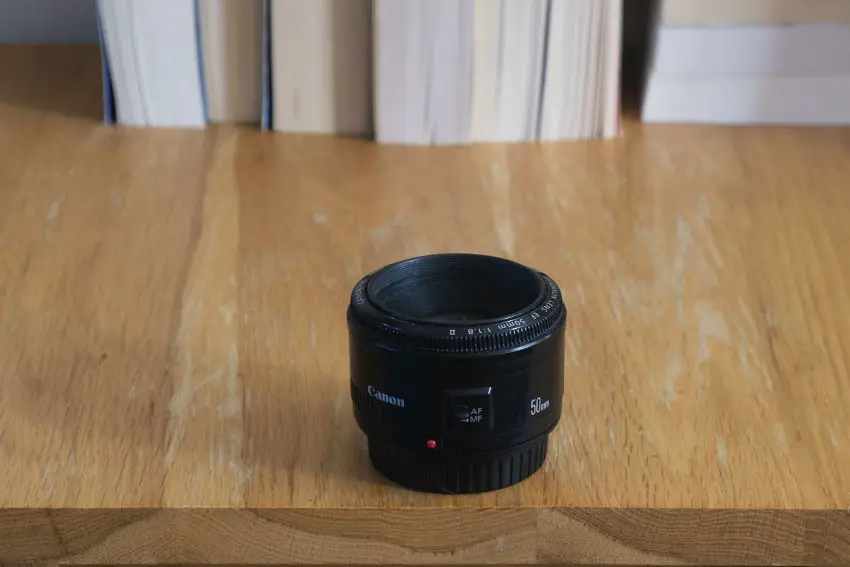
You won’t find weather sealing here; honestly, you shouldn’t expect any. So as long as you don’t leave it out in the rain, this lens will last a long time.
The STM motor works excellently; it is nearly silent and focuses smoothly. The lens has some issues focusing near infinity on some DSLRs, especially APS-C ones. But that varies from copy to copy.
It weighs 160g, so you will barely notice that you have a lens attached. It is pretty compact, and you’ll find it easy to handle.
Who is the Canon EF 50mm f/1.8 STM for?
If you shoot portraits and groups and want some background compression and bokeh, but your budget is quite tight, the 50mm lens is perfect for you.
In fact, even if you have the budget for other lenses, this is a great backup lens since it is dirt cheap and a good performer, putting it among the best lenses for family photography.
- Pros:
- Great image quality.
- It is extremely light and compact.
- Nice and almost quiet STM focusing motor.
- Very cheap at just $130.
- Nice background blur.
- Wide aperture at f/1.8.
- Excellent price to performance.
- Cons:
- No weather sealing.
- No image stabilization.
- Focus can be inaccurate when focusing near infinity with some copies.
Read More:
3. Sigma 35mm f/1.4 DG HSM Art
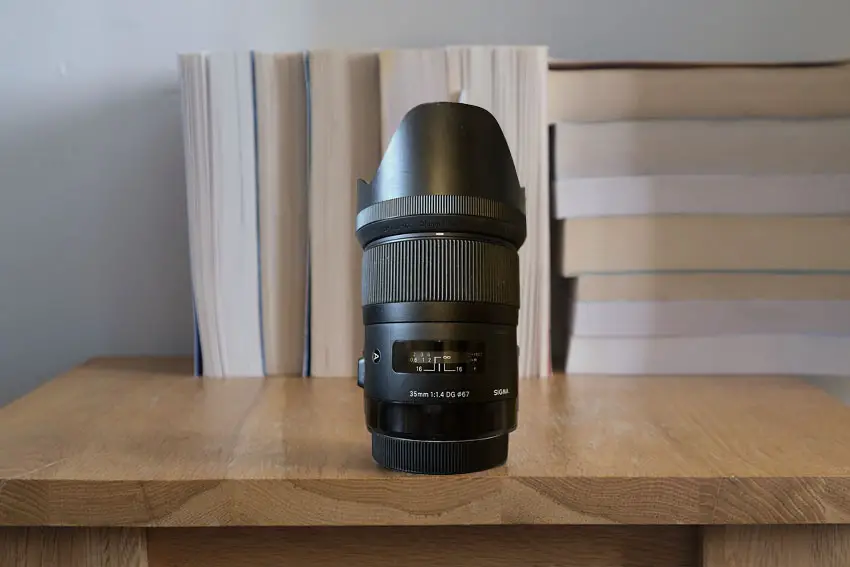
Specifications:
- Mount: EF Mount
- Closest Focusing Distance: 30cm / 0.98ft
- Maximum Magnification: 0.19x
- Autofocus Type: HSM
- Image Stabilization: No
- Filter Thread: 67mm
Sigma is the leading third-party lens manufacturer, often offering lenses you can’t find with other manufacturers. Their Art line of lenses is designed with as few compromises as possible, and they are usually very well built with razor-sharp optics.
Image Quality
This 35mm lens is among the sharpest 35mm lenses you can mount on a Canon camera, especially sub $1000 lenses.
Wide open it is extremely sharp in the center, with some sharpness fall-off towards the extreme corners. By f/2, it gains even more sharpness throughout the whole frame, and by f/4, it is razor sharp from corner to corner. There is a slight corner sharpness increase at f/5.6, but you won’t notice it.

Closing the lens to f/8 provides no sharpness benefits, and closing it further, you’ll start noticing the effects of diffraction, where the lens starts to lose sharpness. At f/16, with the sharpness lost due to diffraction, it is still sharper than many of the 35mm lenses on the market, which is an incredible feat.
There is around a -2EV vignette when the lens is wide open, which reduces to -0.5EV at f/2.8. F/1.4 lenses often exhibit vignetting when wide open. However, on an APS-C camera, that vignette is not an issue.
If you shoot in high contrast scenarios you’ll notice that the Sigma 35mm f/1.4 has very little chromatic aberration, which is great. It has some longitudinal chromatic aberration which shows up as purple/green fringing in out of focus areas. This is a bit harder to correct in post production, but luckily there isn’t a lot of it.
Flaring and ghosting is very well controlled, with slight flare and ghosting being noticeable when you shoot directly into the sun.
All in all, image quality wise, the lens is as great as it gets.
Build Quality
When you first get this lens in your hand, you’ll notice that it is a bit heavy, weighing in at 665 grams. Then you’ll notice the build quality and how good it is, being a mix of metal mount and base, with Sigma’s proprietary Thermally Stable Composite for the rest of the lens.
The TSC is essentially a proprietary polycarbonate developed by Sigma which expands and contracts similarly to aluminum, which means that every element in the lens will handle temperature differences equally. So it won’t get looser over time.
Even though the lens is built well, it is not weather sealed. So keep that in mind. The HSM autofocus, on the other hand, is nice and quick and produces no sound except almost inaudible clicks when it changes direction.

When it comes to focusing accuracy, on the other hand, your mileage might vary. Sigma lenses tend to focus well with cameras with simpler autofocus systems and often get confused with cameras with more complex autofocus systems.
On top of that, the autofocus might differ from one copy to another, so you might need to get the Sigma USB dock to calibrate your copy for your camera. The lens will focus perfectly in Live View mode, especially with cameras that have DPAF. Moreover, you won’t find many focusing issues using this lens via an adapter on mirrorless cameras.
Who is the Sigma 35mm f/1.4 DG HSM Art lens for?
If you shoot larger groups of people with the occasional close-up portrait, and you want to capture more of the environment with zero image quality compromises, then this lens is for you. It is not the cheapest, but it is worth every penny.
- Pros:
- Exceptional image quality, even when wide open.
- Very well built.
- Has excellent control over chromatic aberration, distortion, and flaring.
- Fast and silent autofocus.
- Accurate autofocus for older cameras, mirrorless cameras, and cameras with DPAF in live view.
- Cons:
- Autofocus can be problematic for some.
- No weather sealing.
- No image stabilization.
Read More:
4. Canon EF 24-70mm f/2.8L II USM
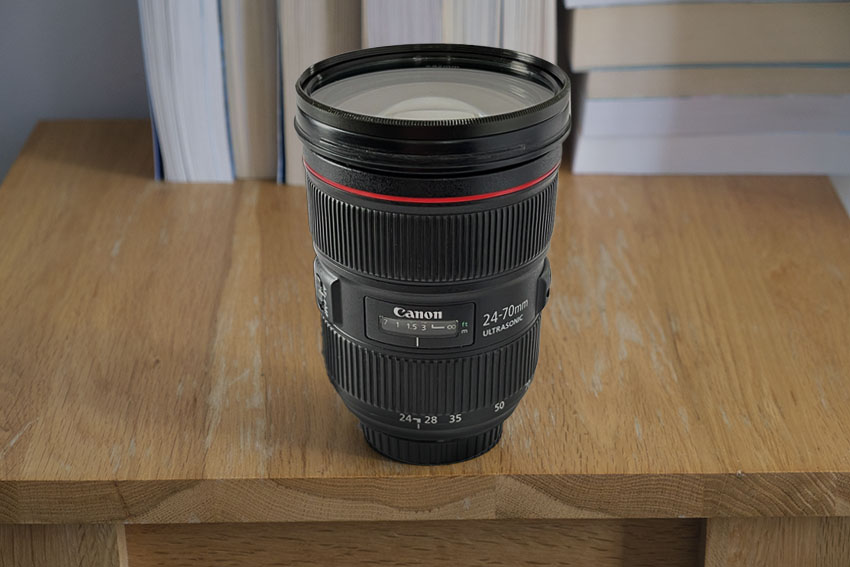
Specifications:
- Mount: EF Mount
- Closest Focusing Distance: 38cm / 1.24ft
- Maximum Magnification: 0.21x
- Autofocus Type: USM
- Image Stabilization: No
- Filter Thread: 82mm
Canon’s 24-70mm f/2.8L lenses are mostly used by professionals who shoot events and weddings. The constant f/2.8 aperture is quite well-regarded in situations like this.
Image Quality
The lens is quite sharp throughout the zoom range, with a slight sharpness fall-off towards the corners. Sharpness increases slightly if you stop down to f/4 and peaks at f/5.6. After that effects of diffraction start to kick in, and the sharpness reduces. At f/22, the sharpness is visibly reduced. However, it is still decently sharp, which is a great feat for a zoom lens.

Wide open, the lens shows a -2EV vignette at 24mm, which improves to -1.4EV at 35mm, worsens significantly to -3EV at 50mm, and then recovers back to -2EV at 70mm. Stopping down the lens to f/4 reduces the vignette to -1EV throughout the whole range, except at 24mm, where the vignette is -1.7EV. At f/8, all ranges except 24mm show a -0.5EV vignette and -0.8EV at 24mm.
There is some CA present, though not much. It is a bit worse on the long end, towards 70mm, but you can quickly correct that in Lightroom.
If you shoot things with straight lines, you’ll notice a slight barrel distortion when shooting at 24mm, which slowly shifts towards slight pincushion distortion towards 70mm. This distortion is a non-issue since it is very slight, and it can be easily corrected.
Flaring and ghosting are very well corrected, and you need to intentionally try to produce flares and ghostings to see some slight rendition of both.
Colors and contrast are excellent, as should be expected from a Canon L glass.
Overall, the image quality is excellent, and it lives up to the Canon L series lens reputation.
Build Quality
Canon made this lens to survive the apocalypse. Even though the lens is made from a combination of plastic and metal, it is extremely durable.

These lenses are intended for professionals that will bump, hit, drop, and dunk these lenses all the time. Wedding photographers, for example, don’t have the luxury to stop shooting if it starts to rain. So, the lens is very well weather sealed and should handle pouring rain without any issues. Dust is also a non-issue.
The autofocus, due to the USM motor, is fast and accurate. L lenses have better-focusing systems than non-L counterparts.
In this case, the lens focuses really fast, and it has zero issues with any Canon body you attach it to. You might hear some lens elements moving inside while focusing, but you might need a stethoscope for that.
Being a wide apertured zoom lens, it will be on the heavier side. All that weather sealing and protection also adds to the weight as well. So expect to hold 800g more on top of your camera weight.
Who is the Canon EF 24-70mm f/2.8L II USM for?
If you shoot family portraits, and you want to shoot some family gatherings and events as well, on top of that, do you want one lens to rule them all? Well, this is it. It is not cheap, pro glass never is, but you won’t need to replace it for a decade at least.
- Pros:
- Exceptionally sharp throughout the zoom range.
- Well-controlled chromatic aberration, distortion, and flare.
- Weather sealed to the highest standards.
- Tough and rugged, intended for the pros.
- Fast, quiet, and extremely accurate autofocus.
- Cons:
- Vignetting can be annoying for some.
- Expensive.
- No image stabilization.
5. Sigma 50-100mm f/1.8 DC HSM Art
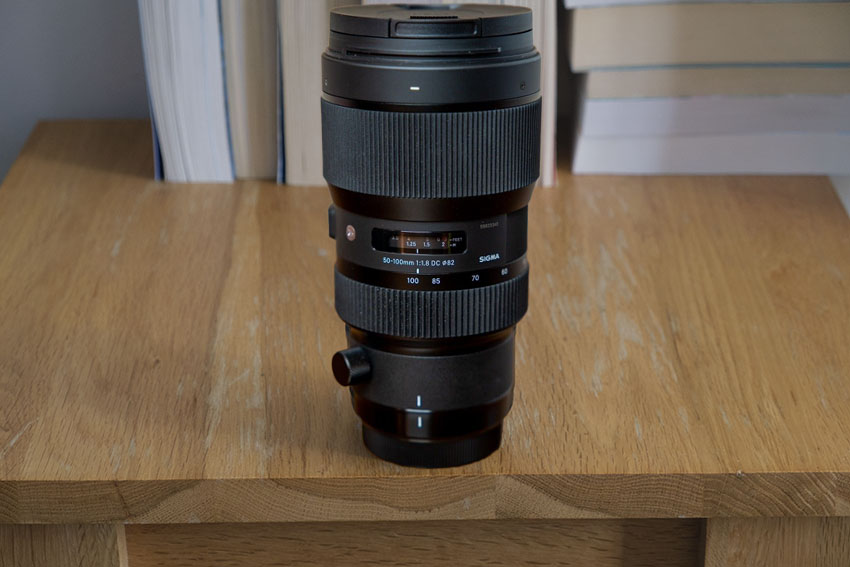
Specifications:
- Mount: EF Mount, but for APS-C cameras.
- Closest Focusing Distance: 95cm / 3.11ft
- Maximum Magnification: 0.15x
- Autofocus Type: HSM
- Image Stabilization: No
- Filter Thread: 82mm
The 50-100mm f/1.8 is one of the revolutionary Sigma lenses. It is the second Sigma lens to incorporate f/1.8 as the constant aperture throughout the zoom range.
Image Quality
Because there are no other lenses in this focal range with that constant aperture, one would expect that the aperture is just a gimmick.
However, the lens is incredibly sharp throughout the zoom range when wide open and sees just marginal sharpness improvement up to f/4. There is not a lot of sharpness fall-off towards the corners, which is great.
Vignetting is decently controlled at -1.3EV, and it clears up completely at f4, which is great.
Chromatic aberration is very well controlled, too. You won’t see too much CA anywhere. The very small amounts present can be easily removed by enabling profile corrections in Lightroom. The same applies to distortion, and you will have to really look closely to notice it in certain conditions. In other words, it is a non-issue.
Flaring and ghosting, on the other hand, are quite present. So you’ll have to be careful when using this lens towards the sun or other strong light sources as it can make a mess out of your photo quite quickly.
When the lens doesn’t flare like crazy, the color and contrast rendition are excellent, among the best. The background blur is extremely well rendered as well. It competes with the smoothest of prime lenses in that regard.
Build Quality

The lens is built out of metal and Sigma’s own TSC polycarbonates. It feels solid and tough. Sadly it is not weather sealed. The rigidity instantly tells you that this lens will take a beating and still operate properly.
The only confusing design choice here is the tripod collar, which is non-removable but covers a part of the zoom ring. Some users may find this annoying to use. You can rotate the collar to get it out of the way, but no matter where you put it, you will eventually hit your fingers when zooming in and out.
Usually, Sigma (and other third-party lenses) has issues with autofocus due to the top-secret focus algorithms that camera manufacturers have. Luckily this lens is among the better autofocus performers out there, and most of the inaccuracies can be ironed out with the Sigma USB dock.
Bear in mind that this lens is heavy. 1.4 kilograms of metal, fancy plastics, and glass. Add the weight of your camera to that, and you will be easily hauling 2 kilograms of camera gear, and you won’t have an image stabilizer to help you out with the camera shake.
In other words, this lens is not for the faint of heart.
Who is the Sigma 50-100mm f/1.8 DC HSM Art for?
If you use APS-C cameras and you want the full frame 70-200mm f/2.8 look, then this lens is the right choice. Of course, be ready for a heavy lens that will set you back $1000.
- Pros:
- Exceptional image quality.
- Very sharp when wide open throughout the full range.
- Handles vignette, distortion, and chromatic aberrations very well.
- Wide constant aperture at f/1.8.
- Great build quality.
- Cons:
- Quite heavy.
- Quite long minimum focal distance at 95cm.
- Poorer control of flaring.
Canon RF Lens Mount
6. Canon RF 85mm f/2 IS STM Macro [Best RF Lens for Family Portraits]
Specifications:
- Mount: RF Mount
- Closest Focusing Distance: 35cm / 1.14ft
- Maximum Magnification: 0.5x
- Autofocus Type: STM
- Image Stabilization: Yes
- Filter Thread: 67mm
Image Quality
Being a relatively new lens, the RF 85mm f/2 is an excellent performer. It is intended to be the 85mm f/1.8 USM mirrorless successor, with some added bells and whistles.
That led Canon to produce this lens which is quite sharp, wide open, with just a little sharpness fall-off towards the corners. Stopping down the lens towards f/5.6, you’ll notice a moderate sharpness increase.
Chromatic aberration, vignetting and distortion is very well controlled, and they all go away when you turn on profile corrections in Lightroom or Capture One. So you need not worry about that.
The image stabilization will correct 5 stops of camera shake, according to Canon. In real-world scenarios, it is slightly less than that, but it is an exceptionally well-stabilized lens nonetheless.
You’ll notice that the lens handles flare very well, and the colors and contrast are rendered exceptionally well.
Moreover, as an added bonus, the lens has macro capabilities, which will come in handy if you need to shoot some details.
Build Quality
![Canon RF 85mm f/2 IS STM Macro [Best RF Lens for Family Portraits]](https://www.lapseoftheshutter.com/wp-content/uploads/2022/08/Canon-85mm-macro-lens.jpg)
The lens is mainly made of high-grade Canon polycarbonates on a metal mount. This means that it might not be rugged as the 24-70mm f/2.8, but it will survive some rough handling. It feels solid and well-balanced in hand and is relatively lightweight. You won’t get fatigued easily shooting with it, even if you use one hand.
The control ring which is a feature on all RF lenses, is an added bonus, as you can program it to control a variety of parameters of the camera, like exposure compensation or ISO, for example.
The STM autofocus works great. It is not as fast as a USM autofocus motor, but it is very accurate. You won’t have many shots that are out of focus since you are working with a very effective mirrorless autofocus system.
Who is the Canon RF 85mm f/2 IS STM Macro for?
If you own a Canon mirrorless camera and you need a well-designed, sharp, stabilized, and macro-capable portrait lens that doesn’t cost a small fortune, then this lens is for you.
At $600, it is not exactly a budget offering, but it is not too expensive either. Especially for what you get.
- Pros:
- Great image quality overall.
- Very sharp.
- Good control over chromatic aberration, distortion, and vignette.
- It has image stabilization.
- It can shoot macro up to 0.5x magnification.
- Good price to performance.
- Cons:
- No weather sealing.
- No internal focusing. The front element protrudes outwards when focusing.
7. Canon RF 50mm f/1.8 STM
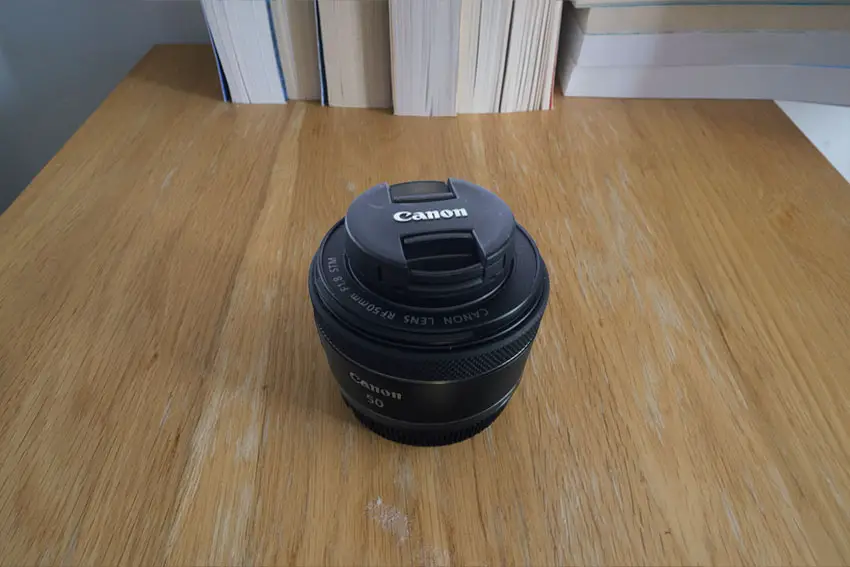
Specifications:
- Mount: RF Mount
- Closest Focusing Distance: 30cm / 0.98ft
- Maximum Magnification: 0.25x
- Autofocus Type: STM
- Image Stabilization: No
- Filter Thread: 43mm
In typical Canon fashion, a “nifty fifty” is necessary. It is not economically viable to adapt the EF 50mm to the RF mount when the adapter costs more than the lens.
Image Quality
In nifty fifty fashion, you can’t expect L glass quality. However, just like the EF version, it is a very good performer for the money.
The lens is quite sharp in the center, with sharpness fall-off towards the corners. Stopping it down improves overall sharpness and brings the corners closer to the center in sharpness.
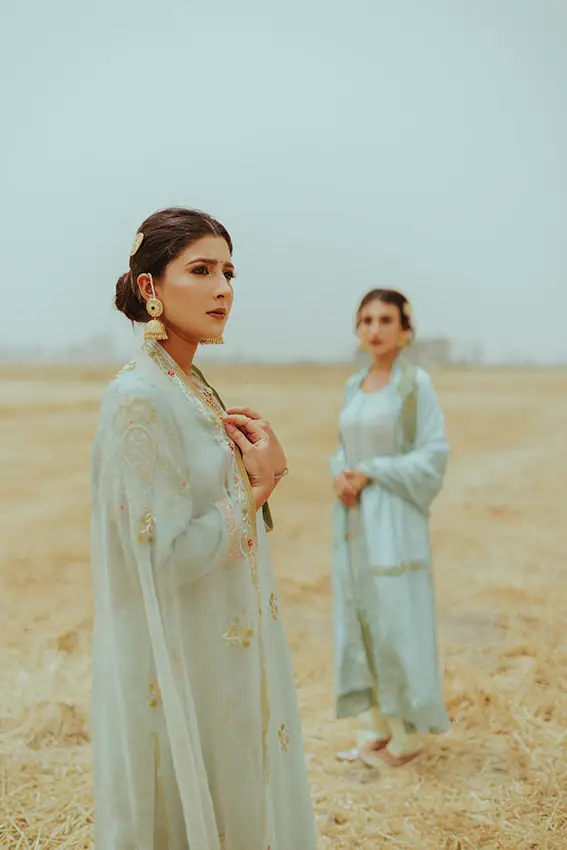
The lens vignettes a lot, with more than -3.5EV reduction in light towards the extreme corners. Stopping the lens down to f/2.8 cuts the vignette in half, and by f/5.6, it is cut in half again. So at f/2.8, you’ll be getting around -1.8EV, and at f.5.6, the vignette will be around -0.85EV.
Other than the vignette, the lens has great control over chromatic aberration, with just a little green and pink showing up in the out-of-focus areas. Distortion is well corrected, too, with it being barely visible when shooting straight parallel lines.
Contrast and colors are rendered very well, with some contrast loss towards the corners. Many photographers will actually find this useful in portrait work.
Flare is well controlled, too, with only barely visible ghosting appearing when the lens is completely closed down and at direct light.
All in all, image quality-wise, the lens is excellent, especially when you factor in the cost.
Build Quality
Even though it is a cheap lens with no image stabilization or weather sealing, the lens is built well. Even the budget RF glass uses decent plastic with high precision tolerances and a metal mount. You can’t expect metal parts except for the mount on a lens this cheap.

This lens has a control ring that doubles as a focus ring. In other words, you can either use the ring for manual focus or as a control ring that manages a setting of your choice. If you are a person that doesn’t use manual focus at all, you have a control ring to use. If you use manual focus often, then you don’t have a control ring.
The STM motor, even though it is not completely silent and fast as the USM motor, it is still quite quick, and the little noise it produces is only audible to you. Your models won’t hear it.
Who is the Canon RF 50mm f/1.8 STM for?
If you are using a Canon mirrorless camera and you shoot portraits and groups while craving some background compression and bokeh, then the RF 50mm f/1.8 is a great choice, especially if your budget is tight.
As with the EF nifty fifty, this is a lens that should be in your kit even if you have the budget for other lenses as a backup.
- Pros:
- Great image quality.
- It is extremely light and compact.
- Solid and almost silent STM focusing motor.
- Very cheap.
- Nice background blur.
- Wide aperture at f/1.8.
- Excellent price to performance.
- Cons:
- No weather sealing.
- No image stabilization.
- Vignette is a bit strong.
8. Canon RF 35mm f/1.8 IS STM Macro
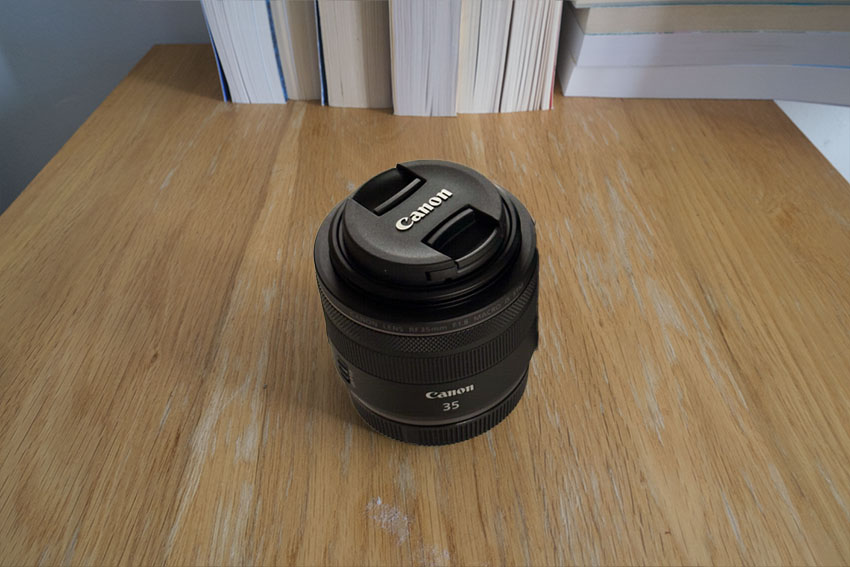
Specifications:
- Mount: RF Mount
- Closest Focusing Distance: 17cm / 0.55ft
- Maximum Magnification: 0.5x
- Autofocus Type: STM
- Image Stabilization: Yes
- Filter Thread: 52mm
Canon tries to make their entry levels a bit higher quality with added extra features, so they are more appealing. This sadly increases the price a bit but still keeps it low enough to be affordable for most of the photographers.
This 35mm Canon RF lens featuring image stabilization and macro capabilities isn’t nifty fifty cheap, but it is cheaper than the 85mm, which features both IS and macro. If you are patient, you’ll find deals on this lens that will drop the price even more.
Image Quality
For most intents and purposes, this lens is sharp, however, the RF 50mm and RF 85mm seem sharper wide open. Sharpness increases significantly when the lens is closed down, and you get the sharpest corner to corner image at around f/4. At f/5.6, the lens is equally sharp as it is at f/4, and after f/5.6, the effects of diffraction start to kick in.

When wide open, you might notice some hazing on high resolution cameras, but it is not too bad. Note that when you enter the macro territory, the corner sharpness suffers a bit more than usual. This might work in your favor by helping with subject isolation, or against your favor if you want the environment sharp as well.
Chromatic aberration is decently controlled, with some fringing appearing in out-of-focus areas. The 50mm and 85mm are better controlled in this regard.
There is no significant or noticeable distortion. Flaring and ghosting is well corrected with the lens producing nice sun stars with 18 rays, which is cool.
The bokeh is rendered nicely, and so are the colors and contrast.
All in all, the image quality can be better, but it is great once you stop the lens down a bit.
Build Quality
The 35mm is equally well built as the 50mm and 85mm STM lenses for the RF mount. Unlike the 50mm, the 35mm features both a focus and a control ring. So you have full manual control over the focus while retaining that control ring for added functionality.
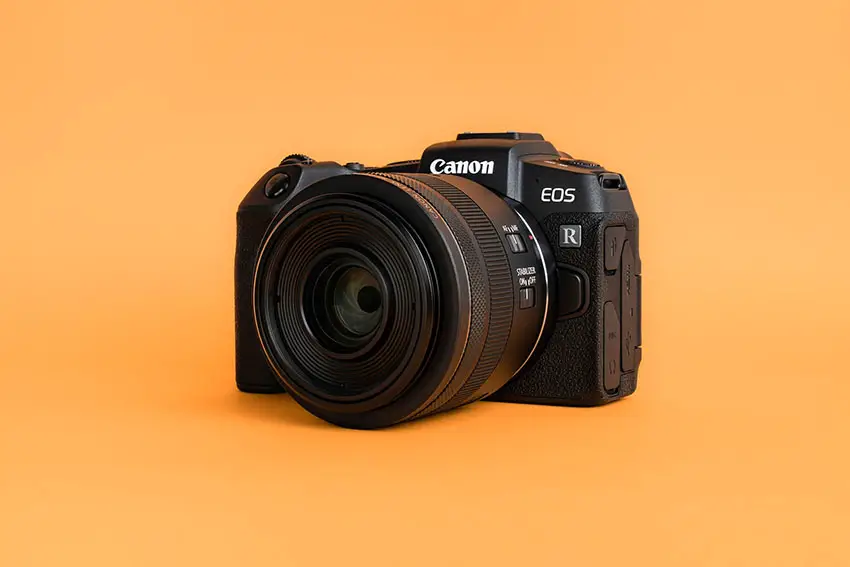
Other than that, there is no weather sealing, and the lens is made from the same high-quality plastic on a metal mount as the 50mm and 85mm. It will survive some harsh love, no doubt about it.
Canon claims 5 stops of image stabilization, which is great. Wider lenses are capable of higher degrees of stabilization.
The autofocus is the same STM autofocus that Canon uses in this lens lineup. Almost quiet, nice, and relatively fast. However, some users reported that this lens can misfocus sometimes, even with powerful mirrorless autofocus systems. This might be due to the slight haze when wide open.
Who is the Canon RF 35mm f/1.8 IS STM Macro for?
If you are a mirrorless shooter and you shoot larger groups of people more often, then this lens is for you.
It will allow you to capture more of the environment, and it will get you by for the occasional portrait or macro shot when necessary. It is a good all-around lens to have in a scenario like this. The price might be a bit off-putting, but it is often discounted significantly.
- Pros:
- Great image quality at f/4.
- It has image stabilization.
- It can shoot macro.
- Good control over flaring and ghosting.
- Affordable if you find it discounted.
- Cons:
- Heavy vignette.
- Sharpness is mediocre when wide open.
- Autofocus can miss sometimes.
9. Canon RF 24-70mm f/2.8L IS USM
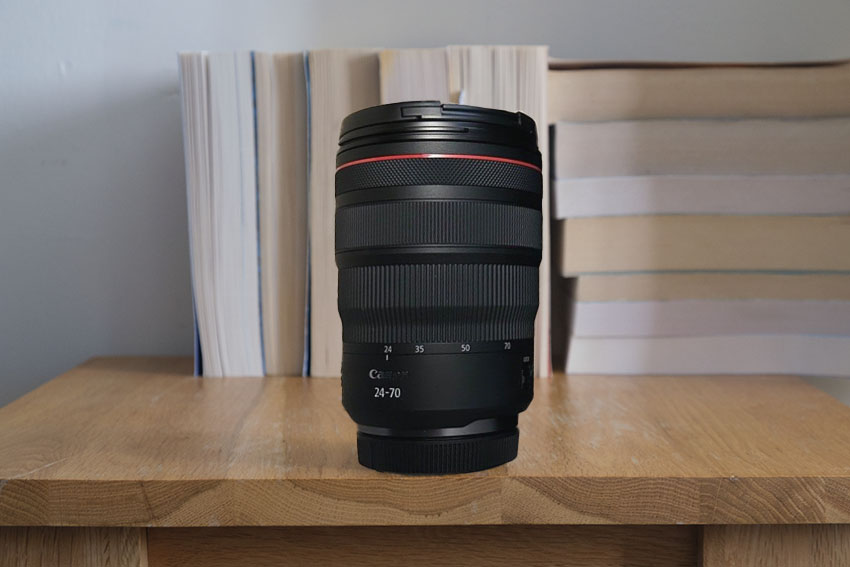
Specifications:
- Mount: RF Mount
- Closest Focusing Distance: 21cm / 0.69ft (wide); 38cm / 1.25ft (tele)
- Maximum Magnification: 0.3x
- Autofocus Type: Nano USM
- Image Stabilization: Yes
- Filter Thread: 82mm
Just like the EF mount, you’ll find a 24-70mm f/2.8 for the RF mount. This time though, the lens features image stabilization which is much welcome for a general-purpose pro lens.
Image Quality
Typical of Canon pro glass, the 24-70mm is exceptionally sharp. The sharpness profile changes with the focal length, and with that at 24mm, the lens is the sharpest wide open at f/2.8. The rest of the focal range is sharpest at f/4. Of course, being a zoom lens, there will be some sharpness fall-off towards the corners, but that is mostly fixed by f/5.6.

The weak side of this lens is the vignette. It seems that Canon RF glass vignettes heavily when it is below 50mm. That is the case here too. There is a -3EV vignette at 24mm when wide open, which falls off to -1.6EV as you zoom in.
At 24mm, stopping down to f/11 still leaves -a 1.6EV vignette, which might bother you when shooting large groups of people.
Zoom in just slightly to 35mm, and wide open, the vignette is -2.2EV, which drops down to 0.86EV at f/8. The vignette goes well below -2EV when you zoom in past 35mm, and it drops to around -0.5EV at only f/5.6.
There is some distortion present, and you will notice it barely when shooting parallel lines, but it can easily be corrected.
The chromatic aberration is well corrected, with very small amounts of it present at 24mm when wide open. All the CA can be corrected via profile corrections in your editing software of choice.
Color and contrast are gorgeous, as per L standards. There is little to no compromise there. There is a little bit of ghosting and flaring, but it doesn’t hinder the photo. It is very slight, and it will just add a bit of character to the image.
Build Quality
Canon L lenses, especially general-purpose ones like this one, which will be used and abused by wedding photographers and photojournalists, are built to last. Even though the lens is mainly polycarbonate (read fancy plastic), it is built like a tank. Featuring a metal mount and the highest grade weather sealing. It will take almost anything you throw at it.
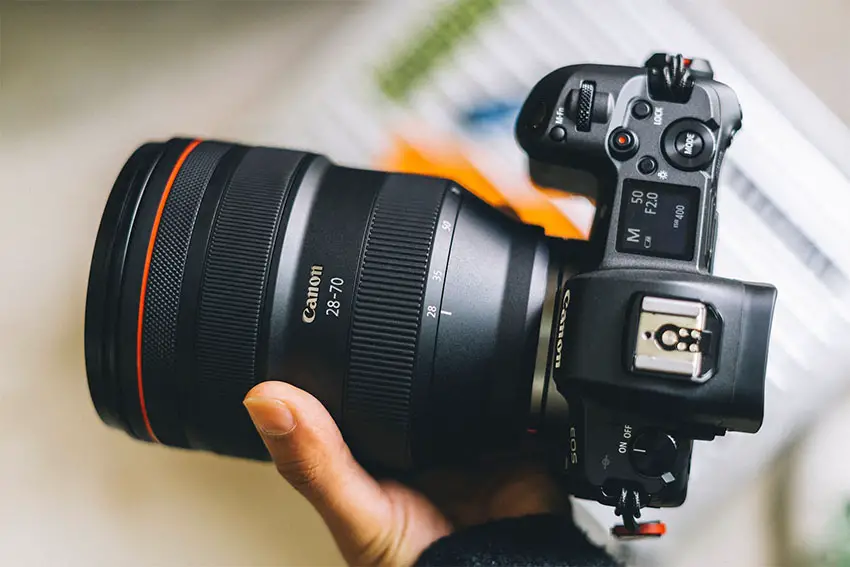
The Image Stabilizer is quite powerful, and it will remove around 5 stops of camera shake, according to Canon.
Autofocusing with this lens is lighting fast and surprisingly quiet. The Nano USM is a combination of the USM motor, with the STM motor. Meaning that it is fast (or faster) and quiet as the regular USM motor but smooth and not as clicky as the STM motor. The best of both worlds. On top of that, this lens rarely misses focus, which is excellent.
It features both a control ring and a focus by wire ring, meaning that you can manually focus this lens while retaining a control ring function.
Who is the Canon RF 24-70mm f/2.8L IS USM for?
If you want one lens to rule all the family portrait needs, and you don’t mind paying more than $2000 for that experience, then this lens is for you. Of course, this only applies if you are a mirrorless camera shooter.
- Pros:
- Exceptionally sharp throughout the zoom range.
- Well-controlled chromatic aberration, distortion, and flare.
- Weather sealed to the highest standards.
- Tough and rugged, intended for the pros.
- Fast, quiet, smooth, and extremely accurate autofocus.
- Great image stabilization.
- You get what you pay for.
- Cons:
- Vignetting can be annoying for some.
- Very expensive.
- Heavy.
10. Canon RF 70-200mm f/2.8L IS USM
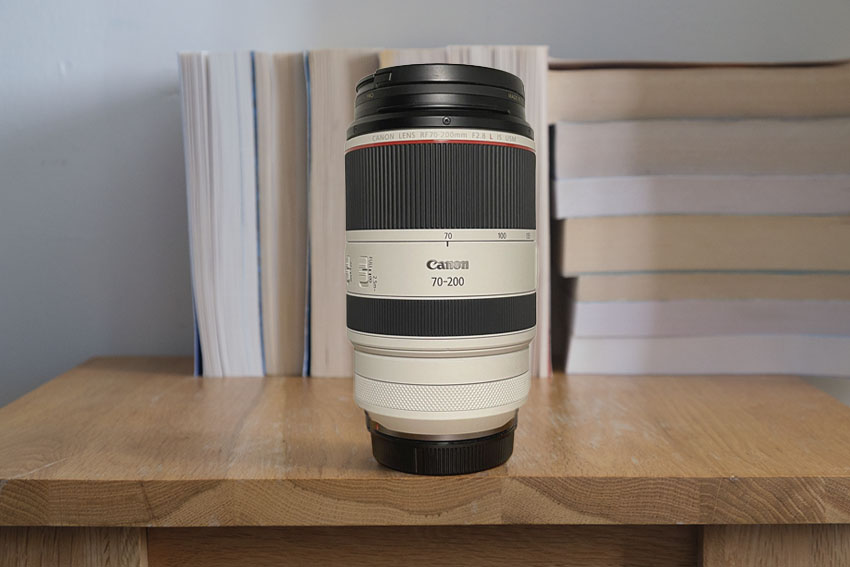
Specifications:
- Mount: RF Mount
- Closest Focusing Distance: 70cm / 2.29ft
- Maximum Magnification: 0.23x
- Autofocus Type: Dual Nano USM
- Image Stabilization: Yes
- Filter Thread: 77mm
Image Quality
Canon’s 70-200 lenses always have stellar optical quality, with as little compromises as possible. There is no perfect glass however, a compromise here and there is necessary. The less compromises, the higher the price. It is simple math, really.
This lens is no exception. Sharpness wise, the lens has stellar performance. It is exceptionally sharp at f/2.8 with little sharpness fall-off towards the corner. It is sharpest at f/4, which is great since you achieve the peak performance of the lens without losing too much light. At f/5.6 center, sharpness remains pretty much the same, with the corners getting even sharper, which increases overall corner-to-corner sharpness.
Chromatic Aberration is exceptionally well corrected, being less than a pixel wide on a 45-megapixel sensor. This means that when you remove it entirely via software, it won’t hurt sharpness at all.
Vignette is well corrected, averaging -0.85EV at f/4. At f/2.8, the situation gets a bit bad if you shoot at 200mm, where you’ll be getting -2.6EV of a vignette. At 70mm and f/2.8, the vignette is a nice -1.16EV, which increases to -1.94EV at 135mm, to reach -2.63 at 200mm.
Flaring and ghosting are nearly perfect, with pretty much no flaring or ghosting visible. Those Canon coatings are doing their job perfectly.
You’ll notice that unlike other 70-200mm, this one handles distortion quite well, with little to no distortion being present. Profile corrections will remove it entirely.
Color and contrast are exceptionally well rendered. Skin tones are rendered accurately with no color shifts at all, and the lens retains nice contrast and micro contrast for those portraits to pop. Out-of-focus areas or bokeh are rendered to high-end prime lenses level, which is rare from a zoom lens.
All in all, optically, this is among the finest lenses Canon produced, which means those family portraits you’ll be going for will benefit from the sharpness and smoothness of the lens a whole lot.
Build Quality
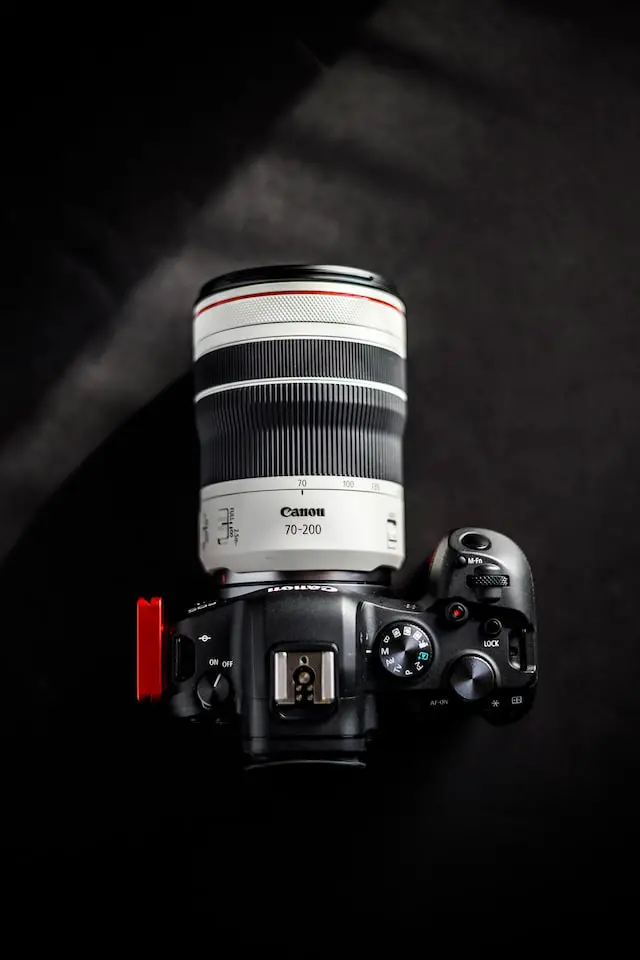
Being a Canon L lens, it is made to last. It is weather sealed to the highest Canon standards, so you should fear no rain. Unlike previous 70-200mm lenses, which didn’t retract, this one does. Meaning that it is quite short when zoomed out at 70mm, which is great for portability and for handling. It is lighter than the EF versions as well. All that, and a durable polycarbonate body on a metal mount, make this lens to be one of the best performers out there.
The control ring is situated at the base of the lens, and the zoom ring is at the top of the lens barrel, with the focus ring and switches in the middle. A bit of an odd design choice, but since the barrel is quite short, it shouldn’t be a problem. It might take a bit of getting used to, though.
The Image Stabilizer promises around 5 stops of image stabilization, and it has two modes to choose from: normal and panning. Panning mode allows you to use the stabilizer to remove vertical camera shake while allowing you to pan left and right without it getting in the way. That is great.
Autofocus, on the other hand, is in a whole different league. By now, we reviewed lenses that had STM, USM, or Nano USM focus motors. But each lens had only one focus motor. Here, in the RF 70-200mm f/2.8L IS USM, there are Dual Nano USM motors. Each one moves separate lens elements for even faster and more accurate autofocus with minimal focus breathing.
This is a first for Canon, and it is great.
Who is the Canon RF 70-200mm f/2.8L IS USM lens for?
Photographers who shoot primarly single person portraits, and portraits of moving subjects (like children) and want the utmost quality and performance.
This is the kind of lens you purchase once, it will cost, but you won’t have the need to replace it for a very, very long time.
Being a lens that is this great, it will hold resale value for a very long time as well.
- Pros:
- Exceptionally sharp throughout the zoom range.
- Well-controlled chromatic aberration, distortion, and flare.
- Weather sealed to the highest standards.
- Tough and rugged, intended for the pros.
- Fast, quiet, smooth, and extremely accurate autofocus via Dual Nano USM motors.
- Great image stabilization with selectable modes.
- You get what you pay for.
- Holds resale value for a long time.
- Compact and relatively light for a 70-200mm lens.
- Cons:
- Vignetting can be annoying for some.
- Very expensive.
Final Thoughts on the Best Lenses for Family Portraits
Family portraits aren’t that expensive to get into. Usually, an average 85mm lens will get you by for a long time, and if you choose to go for it and create a business from those portraits, you can then upgrade to the higher-end 85mm lenses or go for the pro zoom lenses like the 24-70mm and 70-200mm lenses.
All in all, you have plenty of choices for every budget and a good upgrade path that doesn’t involve a high price jump.
Our top pick for DSLR shooters

- Excellent image quality for the money
- Rich and true-to-life color and contrast rendition
- Quick and accurate autofocus motor
- Perfect for individual portraits or group shots from a distance
- Excellent price for the performance
Our top pick for the mirrorless shooters

- Great image quality for the money
- Well-controlled chromatic aberration
- Can shoot macro
- Has very good Image Stabilization
- Great price
Read More:

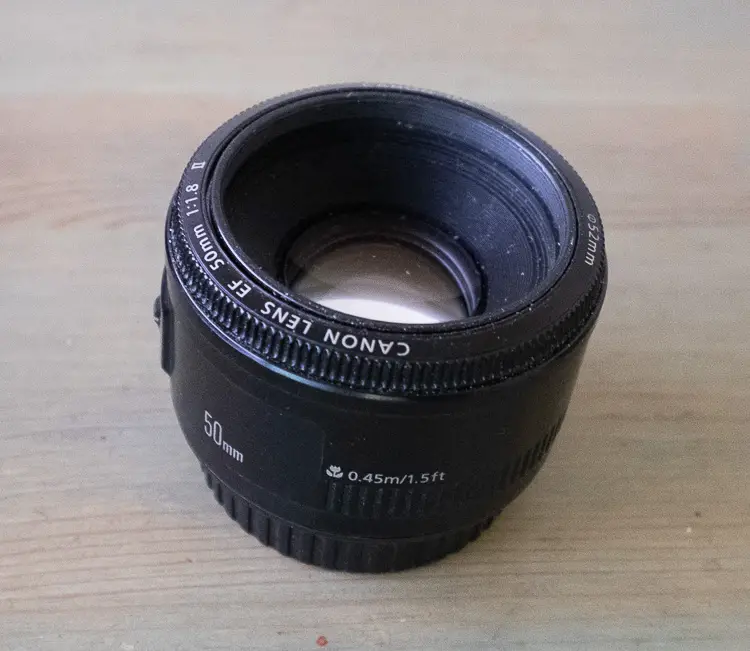












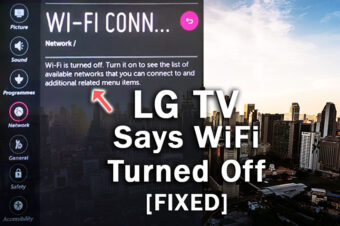
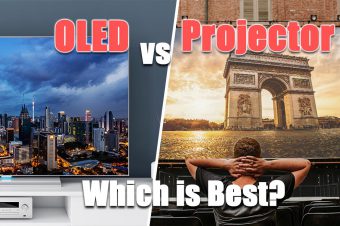
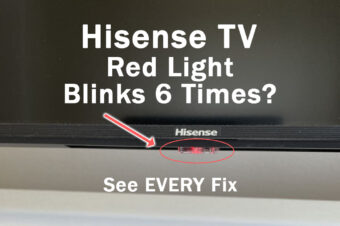
Leave a Reply